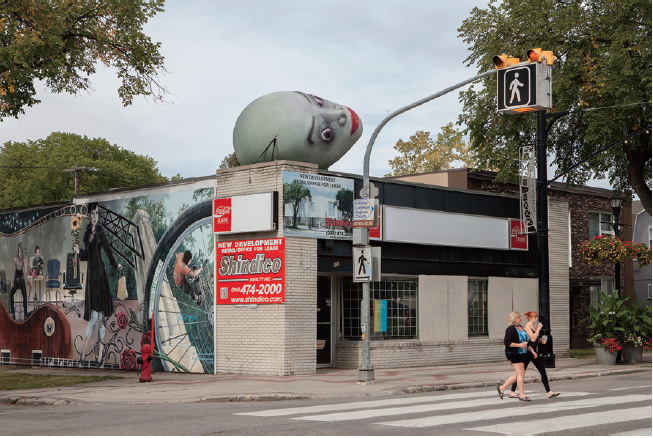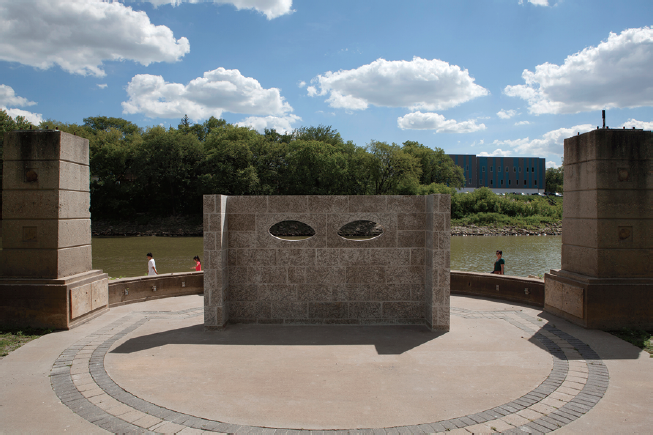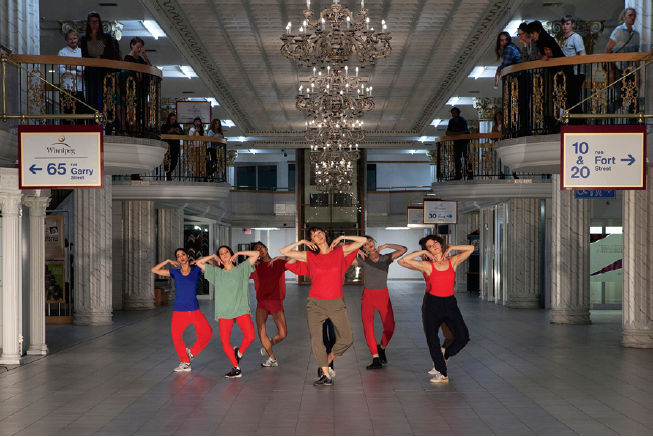“STAGES: Drawing the Curtain”
“I noticed this while walking on Corydon #strangerthings,” commented Sweden1972 on an Instagram post about Erica Eyres’s Head, a large inflatable sculpture looming from the rooftop of a defunct business establishment on a street in Winnipeg. The piece was part of a much larger network of temporary sculptures and performances entitled “STAGES: Drawing the Curtain,” organized by Plug In ICA and curated by the institute’s director, Jenifer Papararo. Between August 18 and September 4, 2017, the pieces occupied various public locations around the city, and encompassed nine international artists; an extensive team of performers, documenters, administrators, installers, exhibition-site guards; and, last but not least, the Winnipeg public. Many people encountered the artworks, far removed from the gallery and inhabiting the spaces of everyday life, totally by chance, thus giving them the impression of “strangerthings.” In her curatorial statement, Papararo describes the multifold encounters and contingencies of the exhibition as a form of moving and breathing, and indeed this unpredictability was integral to the success of the project, which confidently confirmed the purpose of art as a disturbing ripple in our habitual landscapes.

Erica Eyres, Head, 2017, sculpture, nylon, air and electric fan. Photo: Karen Asher. Courtesy of Plug In ICA, Winnipeg.
The piece that initially pulled me into the project was Pablo Bronstein’s exquisite “Peony Unfurling at Various Speeds in Shopping Mall,” a series of dance performances that took place in the main hall of Fort Garry Place—a space known for its weirdly eclectic clash of architectural styles. Co-choreographer Rosalie Wahlfrid, who performed the piece along with seven local contemporary dancers, told me that preparations included studying Renaissance paintings and stills from Ken Russell’s movie The Devils in order to infuse the piece’s repertoire of classic ballet figures with Sprezzatura, loosely translated as “studied nonchalance.” Dressed in comfy sweats, the all-female group of dancers, who had long lost interest in traditional classical perfection and routine, fulfilled this task easily. The playfully rebellious spirit of the dance was enhanced by silence, or, rather, an absence of music in which the ambient noise of the space created a rhythm, a harmony, a kind of music. This synesthesia also affected our sense of time, stimulating an acute feeling of regret for time’s passing while making it seem as if each moment stood still.
Across the street an entirely different series of performances took place. In accordance with an ancient Iranian tradition, Abbas Akhavan repurposed the Bonnycastle Park fountain into a temporary stage, offering it to local drag queen performers, and enabling icons of identity-shifting from the underground clubs to take over a well-exposed public space. Each performance was set to begin on a different day at sunset, emphasizing this transformative power. Some of the more scripted performances were reminiscent of Greek tragedies, while other performers lip-synched through favourite playlists, exposing their personal stories through popular lyrics.

Kara Hamilton, Curtain Wall, 2017, sculpture, Tyndall stone. Photo: Karen Asher. Courtesy of Plug In ICA, Winnipeg.
Nearby, on the river-walk, Kara Hamilton’s interactive sculpture Curtain Wall, a wall of regional limestone with two eye-holeshaped openings tempted me and my friends to insert our heads where the pupils should be, and exchange places looking at the sculpture and out from it. This was great fun, and afterward everyone agreed that the sculpture should occupy the empty amphitheatre permanently. Federico Herrero’s vibrant floor painting, extending along the corridor of the underground tunnel connecting City Hall and Centennial Concert Hall, inspired the same verdict. Happily, Plug In is in negotiations with the city to turn the two pieces into permanent public art. Otherwise, Hamilton’s piece will be dismantled and the hallway floor painted back to grey.
A half-disguised series of works by Ron Tran poked out of the bushes at the busy Forks market, near the river, resurrecting forgotten cultural references to consumer products from the 1940s, and suggesting the sprouting up of buried trash from Winnipeg’s famous Garbage Hill. Criticizing practices of cultural appropriation, Divya Mehra’s Nobody pray for me, the road to hell is paved with good intentions consisted of an enormous illuminated sign with the symbol Om, which was strapped to the back of a flatbed truck and driven through the city streets. One of the times this occurred was on a warm Sunday night, when the piece mingled in traffic alongside a parade of souped-up, old-time cars. Whenever the piece drove past, a crowd of gallery-affiliated spectators sitting on the fence of a parking lot roared with a huge cheer.

Pablo Bronstein, “Peony Unfurling at Various Speeds in Shopping Mall,” 2017, a series of dance performances co-choreographed with Rosalie Wahlfrid. Photo: Karen Asher.
In the haunted basement of The Bay building, Krista Belle Stewart set a sound installation reinterpreting archival recordings of music played by her Indigenous greatgrandmother Terese Kaimetko, and recorded by an anthropologist in the early 1900s. The tactile and sensorially disorienting installation was enhanced by a single live performance by Stewart, Jeneen Frei Njootli and Laura Ortman. Along with an electrically amplified, heirloom violin from Stewart’s family, all the materials for the performance, like soil and antlers, were foraged from the artist’s ancestral land, and made into instruments. With the help of contact microphones, subtle sounds turned into a dangerous earthquake, bringing an acute awareness to the limits of human scale, and translating an apparently insignificant microcosmos into a fatally consequential macrocosmos.
Four floors higher, Toril Johannessen set a stage for her radio drama featuring a scientist programming her AI system, TripleStar, to predict the future of human vision. The piece suggests that as our understanding of our senses changes, perception itself changes, often in dynamic relation to technology. “What are you all looking at?” mused Papararo when visitors on her tour were all attentively staring at an empty backboard in the room, an object repurposed by Johannessen as a screen for reflecting light, while the sound of the play moved through the seven speakers surrounding us. I guess my answer would be: we are looking at the stage, where our attention is habitually required. The brilliant realization encouraged by “STAGES” is therefore precisely that this perceptual instability is due to the lack of a stage, defined as a raised floor or platform. This lack allows for multilocalized and dispersed opportunities for stages in the sense of a point, period or step in a process or development. Even though the project is subtitled “Drawing the Curtain,” its strongest aspect is drawing the curtain away, permitting the audience to participate within, behind and all around the scenes. ❚
“STAGES: Drawing the Curtain” was organized by Plug In ICA and exhibited at various locations in Winnipeg from August 18 to September 4, 2017.
Monika Vrecâr is a PhD student in media theory and a co-editor of the Slovenian literary journal IDIOT.

